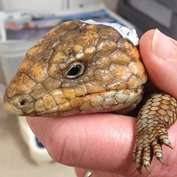First report of virus causing flu-like disease in bobtail lizards

In a world first, Murdoch University researchers have discovered the presence of a new virus in bobtail lizards, which may be threatening the iconic species.
A flu-like disease has led to large numbers of native bobtail lizards going into rehabilitation or care for 20 years with no known cause.
Using next generation sequencing techniques, researchers examined wild bobtails admitted to wildlife care facilities in the Perth metropolitan region and found the existence of a brand new virus species associated with the disease– the first reported in a lizard species in the world.
The findings were recently published by Dr Mark O'Dea, Dr Bethany Jackson, Pally Xavier and Associate Professor Kris Warren from Murdoch's School of Veterinary and Life Sciences and Kanyana Wildlife Rehabilitation Centre's Carol Jackson.
"This is the first report of a nidovirus in lizards globally," said Dr Mark O'Dea.
Co-author and wildlife veterinarian Dr Bethany Jackson said: "Based on numbers presenting to rescue centres, this is one of WA's most common wildlife infectious disease issues, and arguably one of the most urgent disease threats of wildlife in WA.
"This study highlights the importance of next generation sequencing technologies to detect and describe emerging infectious diseases in wildlife species, as well as the importance of rehabilitation centres to enhance early detection mechanisms through passive and targeted health surveillance".
The symptoms of the flu-like disease in a bobtail lizard are similar to the symptoms in humans: snotty nose, weepy eyes, and loss of weight. Mortality rates are reportedly high without supportive treatment and care.
"While sick animals look like they have the flu, it's important to note the virus itself is not an influenza virus," added Dr O'Dea.
"While this virus is statistically associated with the flu-like disease, we have not yet confirmed that it is the cause or that every bobtail infected with the virus will succumb to disease – a bit like flu in humans.
"If this were a more obvious or perhaps charismatic species like a quokka, we would have no doubt seen far greater emphasis on determining the cause and responding."
Kanyana Wildlife Rehabilitation Centre and other groups in the region have been working hard to manage these cases for nearly 20 years, in the absence of a known cause.
The virus, which Dr O'Dea and Dr Jackson have tentatively named Shingleback nidovirus 1, shows some similarity to Ball Python Nidovirus, which causes respiratory disease in pythons overseas.
Dr O'Dea said ongoing research will examine how the virus is transmitted, the effects it has on the survival of bobtails in the wild, and those released after treatment, the requirements for treatment, and development of testing methods, whether it affects other lizard species and where it occurs.
"Further development of diagnostic tools from these findings will aid in the detection and control of this agent across Australia, and potentially in wild lizard populations globally," he said.
All work in this study was carried out with Animal Ethics Committee approval from Murdoch University, and with the permission of the board of Kanyana.
More information: Mark A. O'Dea et al. Discovery and Partial Genomic Characterisation of a Novel Nidovirus Associated with Respiratory Disease in Wild Shingleback Lizards (Tiliqua rugosa), PLOS ONE (2016). DOI: 10.1371/journal.pone.0165209
Journal information: PLoS ONE
Provided by Murdoch University




















